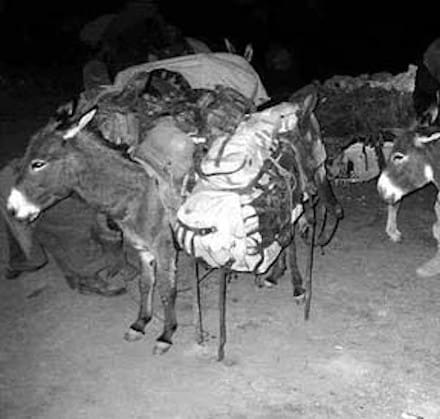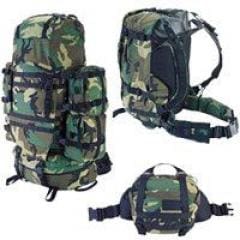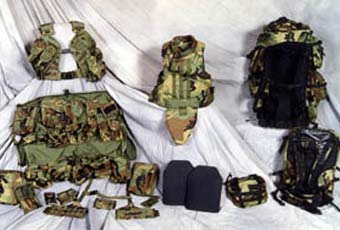Around 1999 SOCOM started issuing a pack system by Gregory/Bianchi, commercially called the UM21. Affectionately, it was known by many who used it as the StrapMaster 2000 for the outrageously long Black 1″ webbing found all over the main pack. Usually issued in Woodland there were a limited number manufactured in 3-Color Desert camo, primarily for 5th Group.
This photo of a burdened mule was taken very early in Operation Enduring Freedom during the so-called Horse Soldier operations. It remains my favorite photo of the UM-21 because one look at the mule’s face and you’ll see how everyone felt while carrying that beast. In fact, you won’t run across many photos of troops actually wearing the Main Pack. Although it did incorporate a few innovative features, the Main Pack was partially manufactured from rubberized fabric and was heavy even when empty. The Main Pack (with PALS compatible side pockets), Patrol Pack and Butt Pack along with 5 stuff sacks made up the system weighing 17 lbs all told.
Although it was fielded as part of the Special Operations Forces Personal Equipment Advanced Requirements (SPEAR) program, it’s design and selection pre-dated the team that fielded such great items as the MICH, MLCS, PCU and SOF Handwear. In fact, it was developed before the Family of Packs was broken out as a separate program from Body Armor/Load Carrying System (BALCS). BALCS ALSO included body armor as well as an Enhanced Load Carrying System subsystems in addition to the UM21.
To learn more, download the UM21 manual.
Tags: Gregory





I’ve been trying to add one of these to my pack horde for a while now, but they still command a decent price on eBay.
what always struck me as odd was the sideways PALS on the SPEAR plate carrier, I’ve only ever seen one person run sideways pouches on it, anyone know the reasoning behind it?
I wasn’t involved in the decision making at the time but this is the way it was explained to me when it was issued…for what it is worth.
Remember this was before 9/11 and body armor was something that SOF strapped on ONLY for actual DA door kicking ops. “Normal” combat Load Carriage was expected to be primarily on the harness /LBV on the top left of the picture.
In fact, the body armor was not expected to be worn as a “stand alone” vest. If the body armor was used, it was envisioned that the LBV would be worn over the body armor vest a la RBA. The LBV would cover most of the armor real estate anyway. Therefore the vertical PALS provided for only very limited options for attaching pouches directly to the armor – if at all.
Like a lot of guys I ran the body armor clean initially for OEF and then into the first year or so of OIF. I ran an AWS vest on top. Eventually everyone saw the utility of attaching pouches on the body armor itself (and also having some kind quick release / ditching capability).
So the old stuff was withdrawn and a newer version of BALCS vest with horizontal PALS was issued starting in 2004-5 if my memory serves. The big Army and USMC had parallel epiphanies and made similar changes to their armor vests over time.
So, bottom line, when this kit was first issued the armor vest was seen as almost an ancillary piece of gear rather than the centerpiece of a load carrying system.
Yeah, it can be explained in one word…SEALs
I wouldn’t necessarily put the onus on just one service. At the time various elements in ARSOF were pulling this process in multiple directions as well. Remember SPEAR was the first real effort by USSOCOM to mind-meld various “Joint” and service SOF requirements into one set of kit.
As often happens with committee work we got the camel and not the high speed horse we wanted. Thankfully – in great part because of the realities of war – things got better fairly rapidly. Still, the UM 21 was clearly a swing and a miss and we shouldn’t try to sugarcoat it.
I’ll put it on one service. NSW kept sending the same guys to the IPT meetings and USASOC as per SOP of the time sent different guys from different units every time. The NSW guys wanted to run their pouches sideways and there wasn’t a consistent voice from guys who had a different opinion. Also, the PM at the time was quite friendly with an NSW IPT member.
Since I wasn’t at the meetings I can’t speak to who shot John on specifics – so I’ll defer to you on that. But, the fact that USASOC couldn’t or didn’t speak with one voice is our fault. If the SEALs got it “their way” it is because we (ARSOF) didn’t have our stuff together.
One of the fellows involved was a good friend of mine from 5th Group who was one of the first SF guys tapped for the Acquisition Corps (kicking and screaming). His version of events was along the same lines.
But he highlighted the totality of the dysfunction – across service lines – and how it was nearly impossible to get anyone (especially USASOC) to clearly articulate what they wanted.
I guess we did at least learn something useful from this first botched effort. Because from my observation we (collectively) are clearly doing better now.
Was it JB?
SSD is actually correct. The SEALs are to blame. They are also to blame for the adoption of the MARCIRAS vice the Land Variant CIRAS (I have no idea why it’s called a land variant) in the SPEAR Armor suit too.
Other than that, the “Strap Master 2000” was actually prefered over the Arcteryx pack the USMC ended up buying. The PM at the time defended his decision with some comment like: “Sometimes doing the right thing means not doing the right thing”. So then the Corps purchased 250k packs at $750 a pop that like this pack, didn’t integrate with armor (even though the ORD said it should).
But products like the ILBE and MTV are what you get when you assign box kickers and label lickers to decision making decision making positions in combat equipment and procurement.
The USMC Pack and Improved Plate Carrier illustraits that there At least was what appeared to have been a brief changing of the guard at the Marines by parties who actually wore the kit.
Now correct me if I’m wrong, because it’s been a while since I had this pack issued, but if I recall correctly, didn’t one of the packs have a padded, flip down, “rucksack flop” butt pad?
Yeah, the Main Pack had this big beaver tail. Really cool pack. Not a good military pack.
Actually the beaver tail was mounted on the middle sized Patrol Pack. It was used to hold some big a$$ radio in place.
I’d still call that monstrosity of a seat on the main pack a beavertail by how it’s mounted.
Déjà vu all over again. I LOVED that picture of the donkey. And your explanation for why the BA webbing ran top to bottom is consistent with what was explained to me when I took over the SOF Team. However, in defense of the previous PM, much of what was done during that time was “one size fits all” , modular was the key buzzword and cheaper was better (often called best value). Remember, we were still paying the peace dividend so solutions often reflected the resources available. There were lots of lessons learned from that era and we learned them in a hurry. Which is why the MICH SEAL comms solution diverged from the Land comms solution, but how the BALCS plate carrier migrated from NSW to the rest of the force. Live and learn.
Oh Fudman, you’ve just got a soft spot in your heart for CM who sure made you guys look good. You and your team did an awesome job whipping that place into shape once you took over.
It should be noted that CM did pretty much all the original SPEAR work herself. While it wasn’t very good in many respects, it was the end product of a LOT of effort. Fortunately, I never had to whip anyone into shape since there really wasn’t anyone there (except Mike) when I arrived. I was lucky to attract some of the most motivated, energetic and innovative people to work for me. They are the ones who did the heavy lifting and deserve the credit for the office’s productivity.
No, it was a great American named Tim Chyma who was a CPT when he was “volunteered” into Acquisition by SF Branch. Tim made Major in 1998-9 but died in 2004 of cancer.
I always try to remember that, as with everything that gets done or fails to get done to standard, there are usually a lot of good people trying damn hard to get it right. So I try not to throw too many stones from inside my glass house.
Tim was our Detachment XO when I with 3ID LRS. Small world.
He’s still alive. He served at PEO Soldier as APM for crew served weapons and then went to SOCOM where he ran SOFSA. I haven’t heard from him in a few years but he was very much alive as recently as 2010. I spoke with him at AUSA.
Holy Crap! You’re right. Tim is a full bird now in some NATO assignment. I just looked him up on AKO. Shit! I’ll have to send him a note and hope he doesn’t mind that I prematurely buried him.
That’s what happens when you get old and all the memories start running together. Now I have to figure out who I mixed him up with – someone who did have cancer.
Back on subject, the manual refers to both the “beavertails” on the main rucksack and patrol pack as “compression flaps”. It is supposed to “store and stabilize loads” as well as providing a seat.
As I recall those that tried to actually use the two packs usually took the flap off to save a little weight.
The butt pack was a fairly useful fanny pack when used alone with the waist strap. I don’t remember seeing anyone actually strap it on the LBV as a buttpack.
TC is alive and well, he is currently serving in an overseas capacity in Mons Belgium. Prior to that he was PEO SOFSA, squaring away that facility to support the operator and SOCOM in a meaningful way.
Now to the pack, it was originally developed by a boisterous group of Chem bio focused SF cats. They wanted to be able to put it on the deck in a contaminated environ, hence the super thick ballistic nylon bottom. Easier to clean. The beaver tail came from folks not wanting to get their ass wet sitting in the snow.
Now, truth be told, SEALs were using the Dana Design Astroplane Overkill, and really not interested in the development of the 21 lb behemoth that became the ‘SPEAR ruck”.
This brings us back to TC, as he was the ‘8’ at USASOC, CM and MR were in the SPEAR office trying to make the new SPEAR cold Wx clothing, Load carriage and packs, as well as look at glove systems.
It was with the hiring of FC as PM, with the ‘Ranger crew” that the PMO took a real operational turn. Those guys rocked and got it done, and nothing slowed them down. (I was on the receiving end of their work at the time) and thankful for it.
The pack went to the wayside and a new system came to play circa 2006.. and has continued to evolve since.
I appreciated this post
Educational post. thanks.
I think that’s a Donkey. They used a lot of donkeys not mules. It’s crazy what we used to make a mission happen or work.
I think it’s a donkey too
And DNA of this piece of gear is still alive in the Eastern Europe: http://krugovik.ru/d/229875/d/image_100.png
Though exceedingly rare, the UM21 does exist in black as well.
http://www.oneirosvalley.com/images/UM21black.JPG
http://www.oneirosvalley.com/images/UM21black2.JPG
http://www.oneirosvalley.com/images/UM21black3.JPG
I remember getting issued this crap. I say crap because it was so f’n heavy and over complicated. I used to zip tie my fast tex buckles to the vertical pals webbing to snap in my SOE Chest rig.
Almost everyone I knew (to include me) used a large, modified ALICE pack. I do remember 19th Group had the really huge Dana Design packs, in black of course.
Then who brought us the MOLLE II bags and then the green two piece before it?
I remember seeing a few of these in the surplus shop off Reilly Rd outside of Bragg…circa 2006-ish. I always wondered what they were. Thanks for the info.
I believe I’ve seen one of those laying around my dads warehouse in 2006/7. 3 color desert. If I remember the tag correctly, it was made by a company called Summit Systems or something like that, but I’ve never found photos of the actual pack.
I went to work for Bianchi/Gregory after finishing my Industrial Design training. Since I had a military background my first job was being in charge of QA for this system. I proudly can say I hand-sewed a UM-21 all by myself as part of getting familiar with this beast and made the only one with OD webbing instead of black. Any time I questioned the design I was told “this is what they wanted”. My introduction to government contracts. I keep one around to remind me what not to do when designing a Military pack.
I got out in 97, but even as far back as ~94-95 I saw quite a few similar looking packs, I remember distinctly one of our NCOs being quite upset because he wasn’t allowed to use it on jumps and was forced to use the ALICE pack we all had, it was more comfortable than the ALICE, or was that a predecessor of this one?
You probably remember the Field Pack, Large, Internal Frame, often called the Vector Ruck or “Gore-tex” ruck. It wasn’t made from Gore-tex but that doesn’t stop Joe from calling an item something it isn’t. Likewise, few knew why they called it a Vector ruck. This general issue pack saw service with the old Light divisions and SOF although the green bottom versions had some issues. One contractor used cotton thread and another failed to follow spec and the waist belt would fall off when the aluminum frame staves would pop out of their tracks which weren’t properly sewn.
As for the Vector name, it comes from the tactical Vector line from Lowe Alpine Systems which originally designed and built the LCS-84/85 pack. These are distinguishable as all green packs or woodland with brown bottoms.
In SF you could jump it but few guys did. They also developed a modified version of it to carry the packable loudspeaker for PSYOPS.